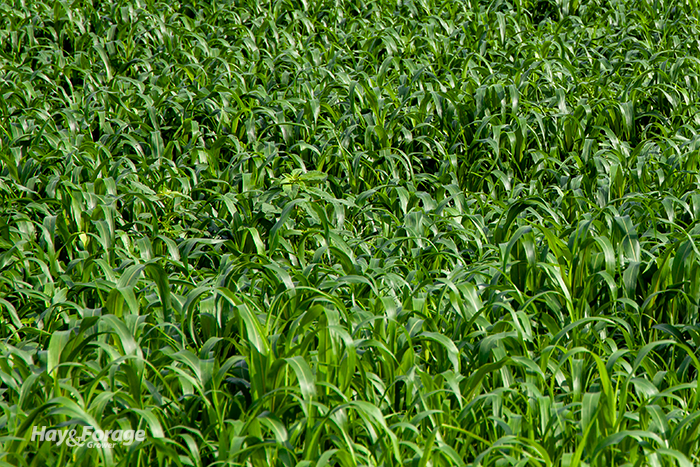
Sorghum species are prominent in providing extra summer forage for grazing or mechanically harvesting. Typically, we hear about farmers planting either forage sorghum or sorghum-sudangrass. Sudangrass is more often an afterthought, but that may be a mistake, according to Mary Drewnoski.
The University of Nebraska beef systems specialist notes that sudangrass can be a great option for summer grazing. “With thinner stems and more leafy growth, sudangrass is less prone to brittleness and breakage than sorghum-sudangrass,” she says. “It also tillers more aggressively, which supports better regrowth during grazing. As a heat-loving, warm-season grass, it thrives during the summer slump of cool-season pastures.”
For optimal production, Drewnoski recommends a sudangrass seeding rate of 20 to 25 pounds per acre. It can then be grazed about 40 days after planting. Research in eastern Nebraska found that 3 animal unit months (AUM) per acre were achieved with rotational grazing and three- to four-day animal moves.
“Sudangrass is relatively drought tolerant,” Drewnoski notes. “While it still needs moisture to germinate, once established, it can continue to produce with limited rainfall. If it catches a rain at planting, it will often — but not always — produce a usable forage crop, even under dry conditions.”
Drewnoski and her team have grazed sudangrass with both cow-calf pairs and stocker steers. For pairs, they grazed one cow-calf unit per acre. Cows maintained condition during peak lactation, and nursing calves, turned out at about 70 days of age, gained 2.5 pounds per day while grazing. No issues with rebreeding were observed. Cows grazing smooth bromegrass over the same period lost some condition, and their calves gained 2.1 pounds per day, which was slightly less than those on sudangrass.
Stockers were grazed at 1.6 steers per acre. They had previously grazed cereal rye and weighed about 880 pounds at turnout. Despite their size, they still gained 1.6 pounds per day on sudangrass.
Achieve sudangrass success
Like most grasses, sudangrass responds favorably to adequate nitrogen and requires recommended soil fertility for high yields. Drewnoski suggests applying 80 to 100 pounds of nitrogen per acre total that is split between two applications. For example, apply 40 to 50 pounds per acre at planting and the remainder in eight to 10 weeks to maintain regrowth and quality into late summer.
Grazing sudangrass early stimulates tillering and improves regrowth. Turn animals on sudangrass when plants are 15- to 24-inches tall. “Don’t be afraid to graze hard the first time — down to 3 inches — to encourage tillering,” Drewnoski says. “Subsequent grazings should leave about 6 to 8 inches of residual. Sudangrass grows fast. If you think it’ll be ready in a week, it will probably be ready in a few days.”
Immature sudangrass is extremely high quality. At 2.5-feet tall, the Nebraska crop tested 63% total digestible nutrients (TDN) and 20% crude protein (CP) in late July. Forage quality drops rapidly with maturity, which is similar to other grasses.
Frequent rotation with a high stocking density helps maintain quality and enhances forage utilization. “Divide the field into three to four paddocks, each sized for three days of grazing,” Drewnoski recommends. “Last summer, a four-paddock system supported one cow-calf pair per acre for 60 days. We had 15 or more inches of regrowth within 10 days of grazing.”
Reduce prussic acid risk
Sudangrass has lower prussic acid potential than sorghum-sudangrass, but it’s not risk-free. Drewnoski says to avoid grazing until plants are at least 15 inches tall and never graze immediately after a frost or during drought stress. After frost, the beef specialist warns to wait seven to 10 days before returning cattle back to the sudangrass. A simple field test can help assess prussic acid levels, if you’re unsure.
For producers needing reliable, warm-season grass grazing, don’t discount sudangrass as a viable option.

